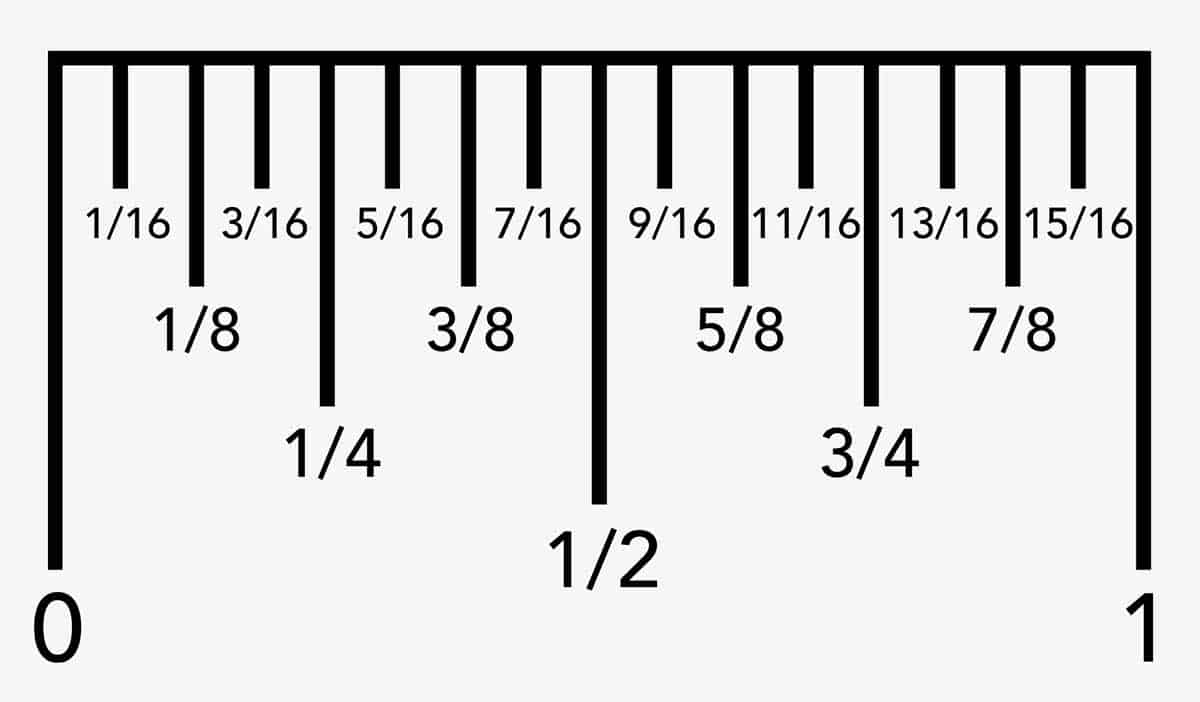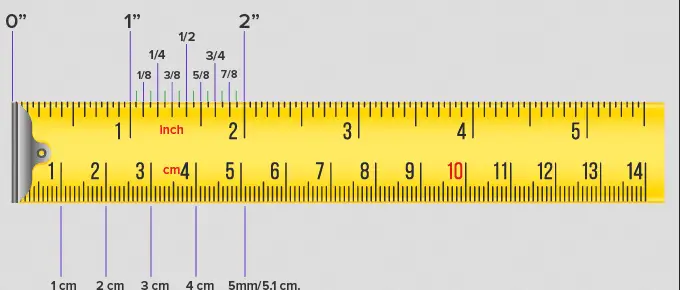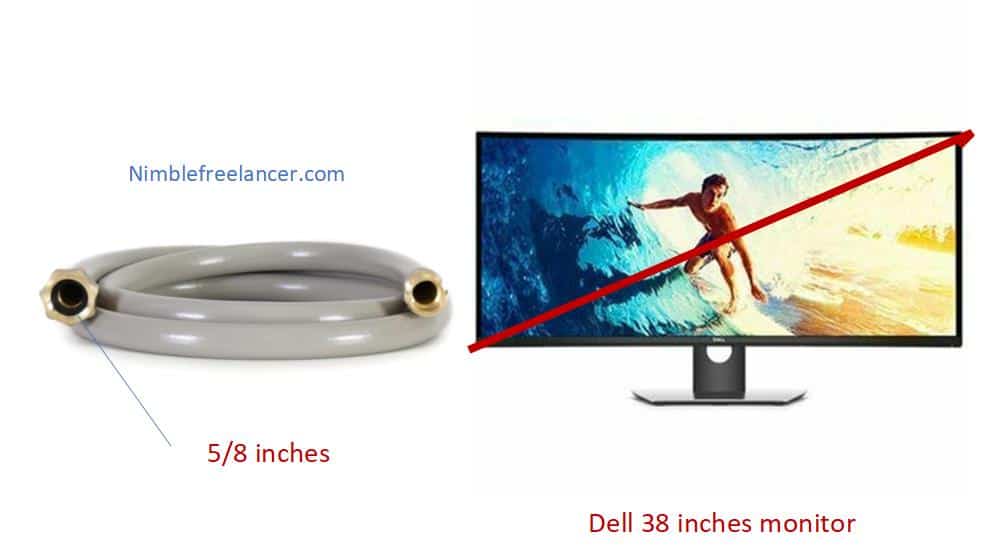Measurements are an essential part of every job. The biggest problem freelancers can see is converting U.S. units to an international system of units.
Let us answer a straightforward question:
What are 5/8 inches to cm?
5/8 inches is 1.587 cm because 1 inch is 2.54 cm, so 5 x 2.54 / 8 equals 1.587cm.
Show me 5/8 on a Ruler!
Rulers are essential tools used as a standard of length measurement in almost all practical applications. Their significance cannot be overlooked, especially in mathematics, geometry, and algebra, as rulers are used in real-world presentations. Reading a ruler in centimeters and inches allows you to compute different items and perform mathematical calculations effortlessly when analyzing geometrical data.
A standard ruler involves a 12-inch or a 1-foot ruler, which can be advantageous in determining an item’s exact size and depth. A ruler is a standard tool or device mainly used to measure the length and dimension of any straight line or object. They are excessively used to quantify size in metric and customary units. Rulers are marked in centimeters, feet, and inches to help understand different measuring variations.
5/8 on a ruler

Where is 5/8 on a ruler?
Five-eighths inch or 5/8 inch on a ruler is a mark between 1/2 inch and 1 inch. When the ruler divides the inches into eighths, 5/8 inch is the fifth mark on the ruler from the left side. For example, if the ruler divides the inches into 16ths, 5/8 inch is the 10th mark.
Most standard rulers in the U.S. show measurements in inches; you’ll find smaller divisions within each inch. The most common divisions are halves, quarters (1/4), eighths (1/8), and sixteenths (1/16). Depending on the ruler’s size and design, it may have smaller divisions.
Finding 5/8 on a Ruler
- Identify an Inch: Find a full inch on your ruler. It’s usually easier to start at the “1” mark.
- Eighths Divisions: If your ruler has lines dividing each inch into eight equal parts, each line represents an eighth.
- Counting to 5/8: Start counting from the left side of the inch. You’ll pass the marks for 1/8, 2/8 (or 1/4), 3/8, 4/8 (or 1/2), and then you’ll hit 5/8. It’s the fifth longer mark after the 0 (start of the inch) mark.
- On a More Detailed Ruler: If your ruler divides inches into sixteenths, then finding 5/8 is a bit different. Remember that are 16 sixteenths in an inch, so half of 16 is 8. This means 8/16 is equivalent to 1/2 inch. So, 5/8 is 10/16 (because five is 10 when doubled, and eight is 16 when doubled). On this ruler, you’ll count ten of the most minor marks from the start of the inch to find 5/8.
What is 5/8 of an inch?
Five-eighths of an inch, or 5/8 inch, represents a fractional length measurement that marks past 1/2 inch and before 1 inch. If the ruler divides the inches into eighths, 5/8 inch is the fifth mark on the left side.
On a 10-inch ruler, you will observe minor marks and lines between zero and 1 inch that highlight one by eight, 1/4, 3/ 8, ½, 5/8, 6/8, or 7/8, and one of an inch. There are 96 distinct large and small markings on a standard 12-inch ruler. However, if you are interested in finding 5/8 on a traditional ruler, then make sure to follow the red marks on the ruler, which are highlighted as 1/16, 1/8, 3/16, 1/4, 5/16, 3/8, 7/16, 1/2, 9/16, 5/8, 11/16, 3/4, 13/16, 7/8, 15/16 and one inch. If you make length measurements with a ruler’s help, you can mark the whole inch, leave some space, and then create an inch, for example, 1 1/2 or 2 3/8.
Standard fraction measurement includes:
3⁄8″ 0.375 9.525
7⁄16″ 0.4375 11.1125
1⁄2″ 0.5 12.7
9⁄16″ 0.5625 14.2875
What is 5/8 on a tape measure?
5/8 on a tape measure represents fraction length measurement that marks past 1/2 inch before 1 inch. 5/8 inch is equal to 1.5875 centimeters. When the tape divides the inches into eighths, 5/8 inch is the fifth mark on the tape from the left side. If the tape divides the inches into 16ths, 5/8 inch is the 10th mark.

5/8 on a tape measure is a fraction that’s more than half but less than a full inch. It translates to approximately 1.5875 centimeters. If the tape displays inches in eighths, 5/8 is the fifth significant mark after the zero. However, if the tape measure divides inches into sixteenths, 5/8 will be the tenth small mark. Always ensure you’re reading from the correct starting point.
How many mm is 5/8 inches?
5/8 inches equals 15.88mm. Therefore, if you convert fractional 5/8 inches in the metric system, you will get 15.88 millimeters. Additionally, 5/8 inches equals 0.625 decimal inches.
Other invaluable measurement tools can remove slight chances of measurement error. In most scenarios, taking care of minute and meticulous measurements is essential to ruin the entire project’s result. Quality measurement tools are available in the market, which help create the layout of the whole project and produce quality results with accuracy and precision. Different tape measurements are available in any hardware store, focusing on particular measurements. It has a reliable and firm hook that can be adjusted at the starting point and moved throughout.
This is considered professional as its durability cannot be questioned, and it is manufactured to tolerate aggressive moves. A speed square is another measurement tool that carpenters and practitioners mostly prefer. It is considered versatile and resourceful as it serves the role of the square protractor, miter square, saw guide, and line scriber. The markings drawn by the speed square will remain close to permanent, giving you a correct standard and marking to figure out the rest of the project. The tool is light, durable, and easy to use in woodcuts.
A protractor works by providing truthful and detailed numerical measurements. It is usually operated by pressing the two legs of the protractor against the surface, which needs to be measured. Lastly, due to technological advancements, measurement tools have been refined and modernized, which includes a long measuring tape used mainly by professionals, architects, and designers. It provides instant results to distances of up to 50 feet.
Let us play a little bit with fractions and decimal places:
What is between 5/8 and 11/16?
Between 5/8 and 11/16 are 41/64, 21/32, and 43/64. We can conclude by knowing that 5/8 equals 0.625 while 11/16 equals 0.6875. 11/16 is 10% bigger than 5/8; in this area, we can see fractions 41/64= 0.640625, 21/32 = 0.65625, and 43/64 = 0.671875.
Is 5/8 equal to 9/16?
No, 5/8 is more significant than 9/16. If we calculate and convert it into decimal, 5/8 equals 0.625, while 9/16 equals 0.563, we can conclude that 5/8 and 9/16 are not equal.
Is 7/16 bigger than 1/4?
7/16 is more significant than 1/4 because 7/16 equals 0.438 while 1/4 equals 0.25. When we compare 7/16 and 1/4, we see that 7/16 is 0.1875 greater than 1/4.
Rulers and fraction measurements
Rulers are used daily to measure objects that are of considerable size. The measurement you will receive using a ruler will be accurate and reliable. One of the noticeable advantages of using rulers is that they are incredibly cheap and easy to find. However, as far as the sizes and dimensions are concerned, they are available in multiple sizes and are manufactured of different materials equipped with various measuring units that can be used for all measurements.
A well-constructed or manufactured ruler has a straight edge for evaluating flaws or minor errors in an object. However, rulers are only used to measure small-sized objects; therefore, if you measure larger-sized things that are probably greater than a yard or meter, other tools are available as reliability decreases with the measurement length.
Rulers have practical applications in real life. You can measure the size of the screen. For example, the Dell 38-inch monitor is a famous monitor whose diagonal length is 38 inches, which is the distance between opposite corners. An additional example can be the Eley 5/8-inch polyurethane garden hose.

Consequently, it can be established that using standard rulers is ideal for small-scale measurements and should be replaced for bigger-sized objects. Rulers only come to a gradation of about 1.5 MM or/16 of an inch. Therefore, there is a high probability of regular reading as the reading can be compromised. Regarding the tasks, the overall tasks can vary and result in discrepancies, leading to a misjudgment or misinformed reading. However, rulers are accessible and valuable for primary and lower-impact jobs. It would help to consider using more detailed measurement devices for precise, meticulous, and high-impact assignments.
Conclusion
Reading a ruler might initially seem tricky, especially when dealing with fractions. With practice, though, it becomes second nature. Whether you’re working on a DIY project or helping with homework, understanding the divisions on a ruler is a valuable skill.
- Facebook Ads to Get Followers! - December 27, 2024
- ClickUp vs. Slack - December 20, 2024
- Mastering E-Commerce Analytics: A Blueprint for Success




